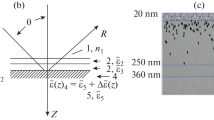Abstract
Adhesion of As–S and As–Se glasses to silica glass is studied by means of the steady detachment method. The results demonstrate that the adhesion strength of the boundary of solid phases increases with the content of chalcogens in the composition of glass. It is found that adhesion of arsenic sulfide glasses with sulfur content over 65% to silica glass exceeds the tensile strength of the silica glass during the process of solidification and annealing of chalcogenide preforms. The adhesion of arsenic chalcogenides to silica glass is determined to be the reason of chalcogenide glass contamination by heterophase inclusions.
Similar content being viewed by others
References
Standler, R.R. and Henderson, R.E., Infrared fiber optics technique, Infrared Phys., 1963, vol. 3, pp. 223–227.
Kapany, N.S. and Simms, R.S., Recent developments in infrared fiber optics, Infrared Phys., 1965, vol. 5, pp. 69–80.
Snopatin, G.E., Shiryaev, V.S., Plotnichenko, V.G., Dianov, E.M., and Churbanov, M.F., High-purity chalcogenide glasses for fiber optics, Inorg. Mater., 2009, vol. 45, no. 13, pp. 1439–1460.
Aio, L.G., Efimov, A.M., and Kokorina, V.F., Refractive index of chalcogenide glasses over a wide range of compositions, J. Non-Cryst. Solids, 1978, vol. 27, pp. 299–307.
Tsuchihashi Shoji and Kawamoto Yoji, Properties and structure of glasses in the system As–S, J. Non-Cryst. Solids, 1971, vol. 5, pp. 286–305.
Borisova, Z.U., Khal’kogenidnye poluprovodnikovye stekla (Semiconducting Chalcogenide Glasses), Leningrad: Leninigradsk. Univ., 1983.
Mel’nichenko, T.D., Fedelesh, V.I., Mel’nichenko, T.N., Sanditov, D.S., Badmaev, S.S., and Damdinov, D.G., On the approximate estimation of the surface tension of chalcogenide glass melts, Glass Phys. Chem., 2009, vol. 35, no. 1, pp. 40–54.
Shiryaev, V.S., Kosolapov, A.F., Pryamikov, A.D., Snopatin, G.E., Churbanov, M.F., Biriukov, A.S., Kotereva, T.V., Mishinov, S.V., Alagashev, G.K., and Kolyadin, A.N., Development of technique for preparation of As2S3 glass preforms for hollow core microstructured optical fibers, J. Optoelectron. Adv. Mater., 2014, vol. 16, nos. 9–10, pp. 1020–1025.
Churbanov, M.F., Snopatin, G.E., Shiryaev, V.S., Plotnichenko, V.G., and Dianov, E.M., Recent advances in preparation of high-purity glasses based on arsenic chalcogenides for fiber optics, J. Non-Cryst. Solids, 2011, vol. 357, pp. 2352–2357.
Mittal, K.L., Adhesion measurement of thin films, Electrocompon. Sci. Technol., 1976, vol. 3, pp. 21–42.
Shiryaev, V.S., Mishinov, S.V., and Churbanov, M.F., Investigation of adhesion of chalcogenide glasses to silica glass, J. Non-Cryst. Solids, 2015, vol. 408, pp. 71–75.
Nemilov, S.V., Viscosity, elastic properties, and valence structure of melts and glasses in the As–S system, Fiz. Khim. Stekla, 1979, vol. 5, no. 4, pp. 398–409.
Bureau, B., Troles, J., le Floch, M., Smektala, F., Silly, G., and Lucas, J., Solid state 77Se NMR investigations on arsenic–selenium glasses and crystals, Solid State Sci., 2003, vol. 5, pp. 219–224.
Silin’, A.R. and Trukhin, A.N., Tochechnye defekty i elementarnye vozbuzhdeniya v kristallicheskom i stekloobraznom SiO 2 (Point Defects and Elementary Excitations in Crystalline and Glassy SiO2), Riga: Zinatne, 1985, p. 244.
Lunin, B.S. and Torbin, S.N., Heat treatment induced defect formation on the surface of quartz glass, Vestn. Mosk. Univ., Ser. 2: Khim., 2005, vol. 46, no. 6, pp. 378–381.
Author information
Authors and Affiliations
Corresponding author
Additional information
Original Russian Text © S.V. Mishinov, M.F. Churbanov, A.N. Gorokhov, D.A. Kazakov, V.S. Shiryaev, A.I. Suchkov, L.A. Igumnov, G.E. Snopatin, 2016, published in Neorganicheskie Materialy, 2016, Vol. 52, No. 7, pp. 773–777.
The article was translated by the authors.
Rights and permissions
About this article
Cite this article
Mishinov, S.V., Churbanov, M.F., Gorokhov, A.N. et al. Adhesion mechanism of destruction of silica-glass surface during the preparation and treatment of optical glassy arsenic Chalcogenides. Inorg Mater 52, 716–720 (2016). https://doi.org/10.1134/S0020168516070104
Received:
Published:
Issue Date:
DOI: https://doi.org/10.1134/S0020168516070104



